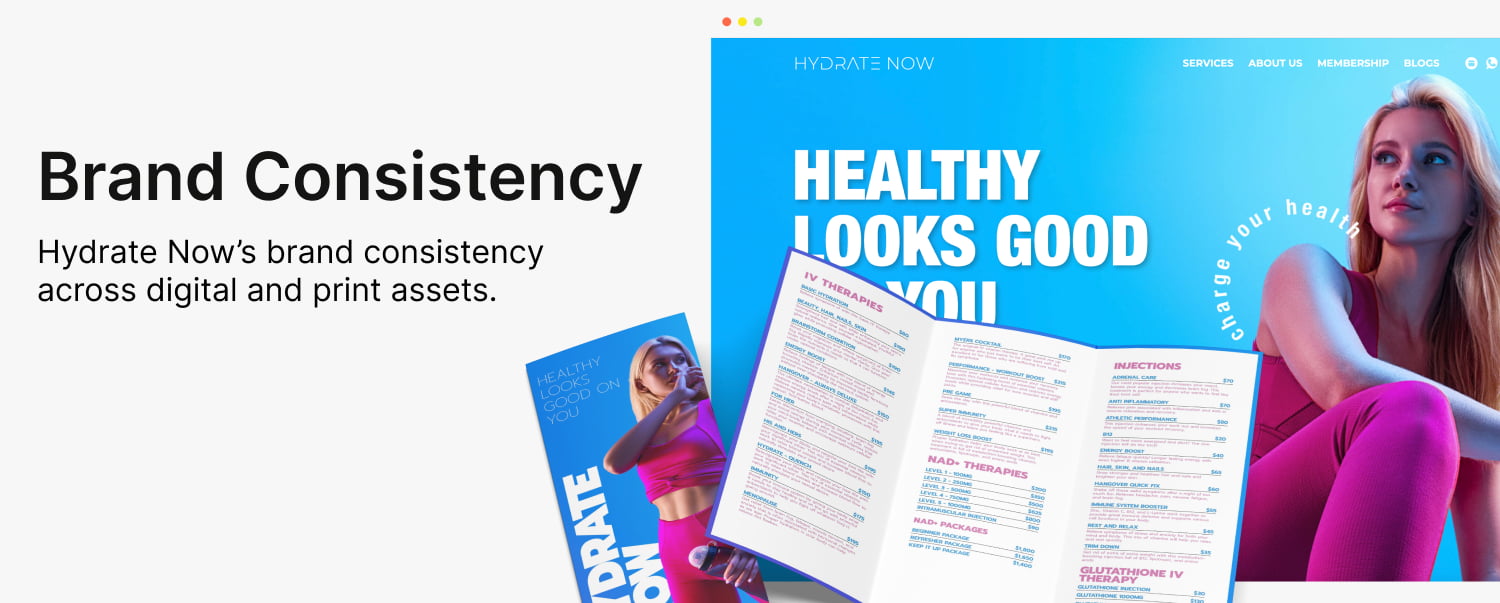
Building a strong and recognizable brand has become a critical component of success for healthcare organizations. With increasing competition and a growing number of patient choices, healthcare providers must differentiate themselves from competitors and build trust with patients through effective brand management.
To achieve this, healthcare organizations need to focus on several key elements, including brand guidelines, brand standards, internal brand training and education, and brand compliance and legal considerations. In this guide, we’ll delve into each of these areas in detail, offering practical tips and best practices to help healthcare providers enhance their brand management efforts.
Whether you’re new to healthcare branding or looking to refine your approach, this guide will provide the information and guidance you need to develop a strong and successful healthcare brand.
Brand guidelines are a critical component of healthcare brand management. These guidelines are a set of rules and recommendations that define how a healthcare brand should be presented and communicated, ensuring consistency and accuracy in brand messaging.
Brand guidelines are designed to help healthcare organizations maintain a strong, recognizable brand identity that resonates with patients and sets them apart from competitors. By defining the core visual elements of the brand, such as logos, colors, typography, and imagery, brand guidelines help ensure that all marketing and communication materials are consistent and align with the brand’s overall messaging and positioning.
Without brand guidelines, healthcare organizations risk creating a disjointed and confusing brand experience for patients. This can lead to a lack of trust in the brand and ultimately harm the organization’s reputation and bottom line.

Effective brand guidelines are a critical component of healthcare brand management. They provide a roadmap for how a healthcare brand should be presented and communicated, ensuring consistency and accuracy in brand messaging.
Brand guidelines typically include several key elements:
By including these key elements in brand guidelines, healthcare organizations can maintain a consistent and strong brand identity that resonates with patients and sets them apart from competitors.
Cleveland Clinic is a prime example of effective brand guidelines in the healthcare industry. Their brand guidelines include detailed recommendations for typography, color, and imagery, as well as guidelines for how to use the brand in both print and digital materials.
Cleveland Clinic’s guidelines are designed to ensure consistency across all marketing materials and channels, from social media to email campaigns to print ads. They provide clear guidance on how to use the brand’s visual elements, messaging, and tone of voice in various contexts.
For organizations looking to develop their own brand guidelines, Cleveland Clinic’s basic identity guidelines are a great place to start.
Developing effective brand guidelines is a critical aspect of healthcare brand management. By providing clear guidelines on how to use the brand across various marketing and communication materials, healthcare organizations can ensure that their brand messaging is consistent and effective. To develop effective brand guidelines, healthcare organizations should follow several best practices.

Brand standards are a set of rules and requirements that govern how a healthcare brand should be used across various marketing and communication materials. These standards ensure that the brand is presented consistently and accurately and that it remains aligned with the organization’s overall messaging and positioning.
Effective brand standards in healthcare are essential to building a strong, recognizable brand that resonates with patients and sets the organization apart from competitors. These standards typically include several key elements that ensure consistency and accuracy in brand messaging, as well as provide clear guidance on how to use the brand across various marketing and communication materials. Some of these key elements include visual elements, messaging, and the appropriate use of brand assets.
Maintaining brand standards is crucial for healthcare organizations looking to build a strong, recognizable brand. By ensuring consistency across all marketing and communication materials, brand standards help establish a strong and cohesive brand identity that resonates with patients and sets the organization apart from competitors.
In addition to maintaining consistency, brand standards can also help save time and resources. By providing clear guidelines on how to use the brand, organizations can reduce the need for costly revisions or rebranding efforts, and streamline the content creation process.
Internal brand training and education are essential components of healthcare brand management. By ensuring that employees understand the brand’s values, messaging, and overall positioning, organizations can maintain consistency in their communications and build a strong, recognizable brand. Moreover, it helps employees to understand how they can contribute to the organization’s overall goals and mission.
Healthcare organizations can offer several types of internal training and education programs to equip employees with the necessary knowledge and skills to represent the brand accurately and consistently. Some of the most common types of training and education programs for healthcare brands include:
Effective communication of the brand is essential for building a strong and recognizable healthcare brand. To ensure that employees and stakeholders are equipped to communicate the brand accurately and consistently, healthcare organizations should consider the following best practices:
By following these best practices, healthcare organizations can effectively teach employees and stakeholders to communicate the brand accurately and consistently. This can help to build a strong and recognizable healthcare brand that resonates with patients and sets the organization apart from competitors.

Brand compliance and legal considerations are essential components of healthcare brand management. It is important to protect a healthcare brand’s intellectual property, such as trademarks and copyrights, and ensure that brand messaging is accurate, consistent, and compliant with relevant laws and regulations.
Trademark and copyright protection is essential for protecting a healthcare brand’s intellectual property. This includes trademarks, logos, slogans, and other brand assets. By registering these assets with the appropriate regulatory bodies, healthcare organizations can prevent others from using them without permission.
Brand infringement and misuse can occur when others use a healthcare brand’s intellectual property without permission or in a way that is not consistent with brand guidelines. This can damage the brand’s reputation and potentially result in legal action. Healthcare organizations should have clear policies and procedures in place to address and prevent brand infringement and misuse.
To protect healthcare brand intellectual property, organizations should consider the following strategies:
By following these strategies, healthcare organizations can effectively protect their intellectual property and maintain a strong and recognizable brand. It is important to stay up-to-date on relevant laws and regulations and take proactive steps to prevent infringement and misuse of brand assets.
Effective brand management is essential for building a strong and recognizable healthcare brand that resonates with patients and sets your organization apart from competitors. If you want to take your healthcare brand to the next level, partnering with Webserv’s professional brand management services can be the solution.
Our team of experts offers a range of services designed to help you build a strong and effective healthcare brand. If you want to learn more about how we can help you maintain your brand book an intro meeting.
However, we understand that some healthcare organizations may not be ready to commit to professional brand management services just yet. That’s why we offer a range of resources and educational materials to help you get started with healthcare branding. Whether you’re interested in developing your brand strategy, improving your website’s accessibility, or enhancing your brand experience, we have the tools and resources to help you succeed.
Healthcare Brand Management involves creating a strong and consistent brand identity for healthcare organizations. It’s important for building trust, establishing a competitive edge, and driving growth.
Effective Healthcare Brand Management includes comprehensive brand guidelines, standards, training, and compliance with legal considerations.
Healthcare companies should consider hiring a professional agency for branding because branding is complex and time-consuming. A professional agency can provide expertise, access to resources, and a team of experts for an efficient and effective process.
Healthcare Brand Management can improve patient outcomes by building trust, creating a positive patient experience, and establishing a reputation for excellence.
Healthcare companies should regularly review and update their brand strategy to ensure it remains relevant, competitive, and aligned with the organization’s goals and values. This can involve periodic audits, patient/stakeholder surveys, and ongoing analysis of industry trends.